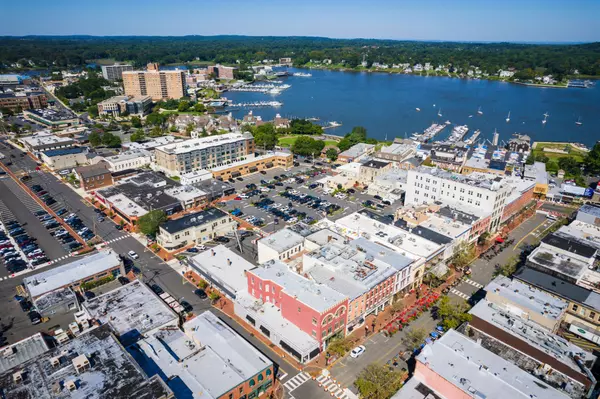Morris County Commercial Real Estate Mid-2025 – Trends, Challenges & Housing Market Connections
A Mixed Real Estate Landscape - Morris County commercial real estate update:
Morris County’s commercial real estate landscape in mid-2025 presents a mixed picture. Industrial and retail properties are experiencing tight vacancy amid strong demand, whereas the office sector contends with elevated vacancy rates (around 27% overall in North/Central NJ as of Q1 2025). At the same time, the residential housing market remains undersupplied – the latest Otteau Group HousingTRAC report shows unsold home inventory creeping up but still only about 2.0 months’ supply (versus 1.6 months a year earlier). This commentary explores key commercial trends (office, retail, industrial) in Morris County as of mid-2025. It compares them with the county’s housing trends, highlighting how shifting work patterns and demographics are linking the two segments.
Residential Market Snapshot (May 2025 Inspired by HousingTRAC Data)
According to Otteau Group’s May 2025 HousingTRAC report, New Jersey’s housing market has cooled slightly from last year’s frenzy but remains historically tight. Year-to-date home sales are down about 3% compared to 2024 (with the sharpest drop in the sub-$400k segment, –15%), even as the luxury $2.5M+ segment saw a 13% increase in activity. Unsold inventory has risen – the number of homes on the market statewide jumped ~43% since January 2025 – yet inventory is still low by historic standards. In Morris County, median prices stayed lofty in 2024 (nearly $1 million for new single-family homes), reflecting persistent demand despite higher interest rates. The buyer-seller ratio (a measure of buyers per 100 sellers) hovers around 50:100, indicating slightly fewer buyers than sellers in a given month – a change from last year’s ultra-tight balance, but still far from a buyer’s market. Correspondingly, the months’ supply of for-sale homes has inched up to ~2 months, up from ~1.6 months in May 2024. Pricing trends confirm a deceleration: after surging in 2024, home prices rose only about 1.2% in Q1 2025 (quarterly) and +7% year-on-year, with forecasts suggesting further slowing of appreciation ahead. In short, the residential side is easing off record highs but remains supply-constrained – a context that both influences and is influenced by the commercial real estate environment.
Office Market: High Vacancies Forcing Reinvention
The office sector is arguably Morris County’s biggest challenge in 2025. Office vacancies have climbed dramatically in the wake of remote/hybrid work trends – Northern New Jersey’s overall office vacancy hit 27% in Q1 2025 (up from 26.6% at the end of 2024), with Class A space even higher at ~30.8% vacant. Morris County mirrors this difficulty: large suburban office parks in areas like Parsippany have struggled to backfill space as companies downsize or relocate. The ongoing shift to remote work has accelerated local office vacancies, even at formerly stable campuses. Notably, the Morris County Planning Board reports a persistent trend of redeveloping underused office sites into new uses. In 2024, Parsippany’s Campus Drive and Sylvan Way office campuses saw several redevelopment proposals – including two warehouse projects and a 280-unit multifamily complex with a luxury fitness club – aimed at breathing new life into obsolete offices. This kind of mixed-use conversion (adding residential, retail, or industrial uses on old office land) is becoming a prominent solution to high vacancies. At the same time, owners of remaining office properties are upgrading amenities – think on-site lounges, coffee bars, and fitness centers – to entice workers back by offering some of the convenience of working from home.
Despite a high overall supply, pockets of demand persist in the office market. Medical and life-sciences users, for example, have been active in absorbing space. In fact, life science companies accounted for over a third of all big NJ office leases in early 2023, including a 260,000 SF lease by Sanofi in Morristown (M Station West). Even in 2024, brokers noted a surge in office leasing transactions for quality space – one local firm completed a 20,000 SF office lease in Parsippany for a professional services company, underscoring that well-positioned buildings can still attract tenants. Healthcare tenants are also on the rise, backfilling some suburban offices with medical uses. The outlook for Morris County offices is thus a tale of two extremes: older commodity offices face pressure to reposition or be redeveloped, while modern or repurposed properties (especially those catering to growth sectors like life sciences, healthcare, or high-end professional services) see opportunistic demand. This divergence directly links to the residential sector – as companies embrace hybrid work, many employees spend more time (and money) in their home locales, shifting some economic activity away from offices and into local housing and retail. Conversely, when an office campus is reborn as a mixed-use center with apartments or townhomes, it interweaves the once-separate office and residential markets, changing the fabric of local communities.
Industrial Market: Strong Demand with New Development
Morris County’s industrial real estate segment continues to be a bright spot in 2025, bolstered by long-running logistics and e-commerce trends. Regional demand for warehouses and distribution space remains robust, even though New Jersey’s industrial market did see a slight cooldown entering 2025. (Notably, a surge of sublease space and cautious occupiers led to a rare quarter of negative net absorption statewide in Q1 2025. In Morris County, however, fundamentals are healthy: the industrial vacancy rate is extremely low, around 2.5% in the “Morris Region” submarket as of late 2023, reflecting a shortage of available modern warehouse space. Average asking rents for Morris industrial space (roughly $6–$12/SF triple-net) remain among the more affordable in the NJ market, which, coupled with the county’s strategic location, continues to attract logistics and manufacturing users. Local officials note that proposals for new warehouse developments slowed in 2024 (about 0.73 million SF proposed, down from a huge 2.66 million SF in 2023), likely due to limited land and a pause after the previous year’s rush. Even so, a consistent trend is underway: developers are repurposing outdated commercial sites (often empty offices) into industrial facilities. A prime example is the former Novartis campus in East Hanover, where Russo Development and Onyx Equities broke ground on a 380,000 SF cold storage warehouse for RealCold in late 2024. That project epitomizes the opportunity in Morris County – converting underutilized corporate campuses into state-of-the-art logistics centers that serve modern supply chains.
Key demand drivers for industrial space remain intact. E-commerce growth and the rise of 3PL (third-party logistics) are keeping pressure on the need for distribution hubs. Industrial brokers report especially strong interest in mid-sized facilities (50,000–200,000 SF), including specialized assets such as cold storage and data centers. Even as new supply is delivered, much of it is quickly absorbed by tenants' “flight-to-quality” – i.e., seeking modern high-ceiling warehouses with prime highway access. Morris County’s geography – crisscrossed by interstates (80, 287, 280) and within a one-day truck drive of 130 million consumers – positions it well as a logistics hub. Investors remain bullish, with ample capital chasing industrial deals due to these solid fundamentals. One challenge to watch is the broader economic backdrop: early 2025 saw some uncertainty (tariffs, interest rates) that briefly tempered leasing activity. However, sentiment is optimistic that as interest rates stabilize or fall, pent-up industrial demand will reaccelerate later in 2025. The industrial sector also ties into residential patterns – the warehousing boom partly reflects changing consumer behavior (more online shopping, accelerated by people spending more time working from home), and it creates jobs that can spur housing demand. Notably, Morris County’s record apartment absorption last year was cited as helping draw more retailers and, by extension, distribution networks to the area, underscoring how industrial growth and population growth can be mutually reinforcing.
Retail Market: Resilient and Adapting
Retail real estate in Morris County has proven resilient through mid-2025, buoyed by an affluent consumer base and expanding residential communities. Across Northern New Jersey, retail vacancy rates hit historic lows in 2024 – in some prime submarkets, vacancy sank below 2%. Morris County’s retail availability also tightened significantly over the past year, though it remains slightly higher than the ultra-low vacancies seen in Hudson/Bergen counties closer to New York City. This means retailers looking for larger footprints or new locations have more options in places like Morris, even as the market is still very healthy. Tenant demand is robust and expected to stay strong through 2025, thanks to a resilient job market and high household incomes in the region. As some office workers return at least part-time, areas like Hudson County saw office occupancy upticks in 2024 that boosted mid-week foot traffic for shops. In suburban markets such as Morris, the key driver has been residential growth: the county recently notched a record in apartment leasing/absorption, and continued growth in households is directly supporting retail expansion. New grocery stores, restaurants, and experiential retail concepts are following the population clusters – for example, rising housing density in parts of Morris is attracting grocery and pharmacy chains, while fast-casual and entertainment-oriented retailers see opportunity where they can find space.
One trend is the integration of retail into mixed-use developments. Many of the new multifamily projects in Morris County (Morristown, Parsippany, etc.) include ground-floor retail or dining, creating walkable environments that blend shopping with living. This dovetails with the housing trends: as more people live in higher-density housing (and as more remote workers spend time locally), demand grows for convenient nearby amenities. Notably, the Planning Board’s report highlights that even when former office sites are redeveloped, they often incorporate a retail component alongside housing – an approach that revitalizes underused properties and meets community needs.
Challenges remain in retail (e.g. labor shortages and the ever-present e-commerce competition), but so far Morris’s shopping centers and downtowns have fared well. Consumer spending has been resilient, and many retailers are adapting by focusing on customer experience and service, something that online shopping can’t replace. The fact that Morris County’s retail vacancy is a bit higher than Gold Coast markets represents an opportunity: it means expanding retailers (including gyms, entertainment venues, and “experiential” concepts) can secure larger spaces here that simply aren’t available in tighter markets. Overall, the retail segment’s stability and growth potential in Morris are closely tied to the positive housing trends (affluent new residents, strong home values) and even the jobs landscape, as long as employment and wages stay solid, local retail should continue to flourish in tandem with the residential community.
Connecting the Dots: Morris County’s Commercial & Residential Interplay
Morris County’s commercial and residential real estate segments do not exist in isolation – they interact in powerful ways. The mixed-use redevelopment wave is a prime example: developers are transforming defunct offices into new combinations of housing, retail, and in some cases, warehouse space. This addresses two issues at once – reducing blight from vacant corporate campuses while easing housing shortages and delivering services to residents. Such projects acknowledge that today’s workforce and retirees alike increasingly value communities where they can live, work, and shop without long commutes. Demographic and job shifts are another linkage. Slower job growth in early 2025 (New Jersey added roughly 4,500 jobs YTD through April vs. 8,300 in the same period 2024) can have a cooling effect on both housing demand and certain commercial expansions. Yet Morris County’s demographics (high education levels, income, and recent influx of residents during the pandemic era) provide a strong foundation that supports both home values and local business activity. The work-from-home trend encapsulates the contrast: it softened office demand but boosted housing preferences (larger homes or suburban moves) and increased daytime spending in residential communities, benefiting local retail and services.
Looking ahead, interest rate trajectories will influence both segments. The Fed’s rate hikes had dampened some buyer activity and investor financing in late 2024, but consensus forecasts see potential rate relief later in 2025. As one local brokerage noted in January, falling interest rates combined with steady demand could “fuel sales and leasing activity” across commercial sectors in late 2025, and the same would unleash pent-up buyer demand in housing. In other words, a sustained decline in financing costs may act as a rising tide lifting all boats, from home sales to office acquisitions. In the meantime, Morris County’s real estate professionals like David Wainwright are navigating a nuanced environment: industrial and multifamily assets are hot commodities, retail is stable and adapting, and office requires creativity and patience. By tracking both commercial and residential metrics – inventory levels, buyer-seller ratios, absorption rates – one gains a holistic view of the market. The mid-2025 data shows a county in transition, but rich with opportunity: a place where new housing and booming logistics facilities are reshaping former office sites, where affluent new residents sustain vibrant retail, and where challenges in one sector can become opportunities for another. The key going forward will be adaptability, as Morris County continues aligning its real estate uses with the evolving needs of businesses and households alike.
Sources: Otteau Group – HousingTRAC Market Report, May 2025; Morris County Office of Planning – 2024 Development Activity Report morriscountynj.gov; Resource Realty (Parsippany) – 2025 Market Outlook Release resource-realty.comresource-realty.com; JLL Research – NJ Office Insight Q1 2025 citybiz.co; NAI James E. Hanson – NJ Industrial Report njbiz.com; Marcus & Millichap – Northern NJ Retail 2025 Forecast marcusmillichap.com; Morris County EDC / Real Estate NJ – industry news and leases morriscountyedc.orgresource-realty.com.
Categories
GET MORE INFORMATION





